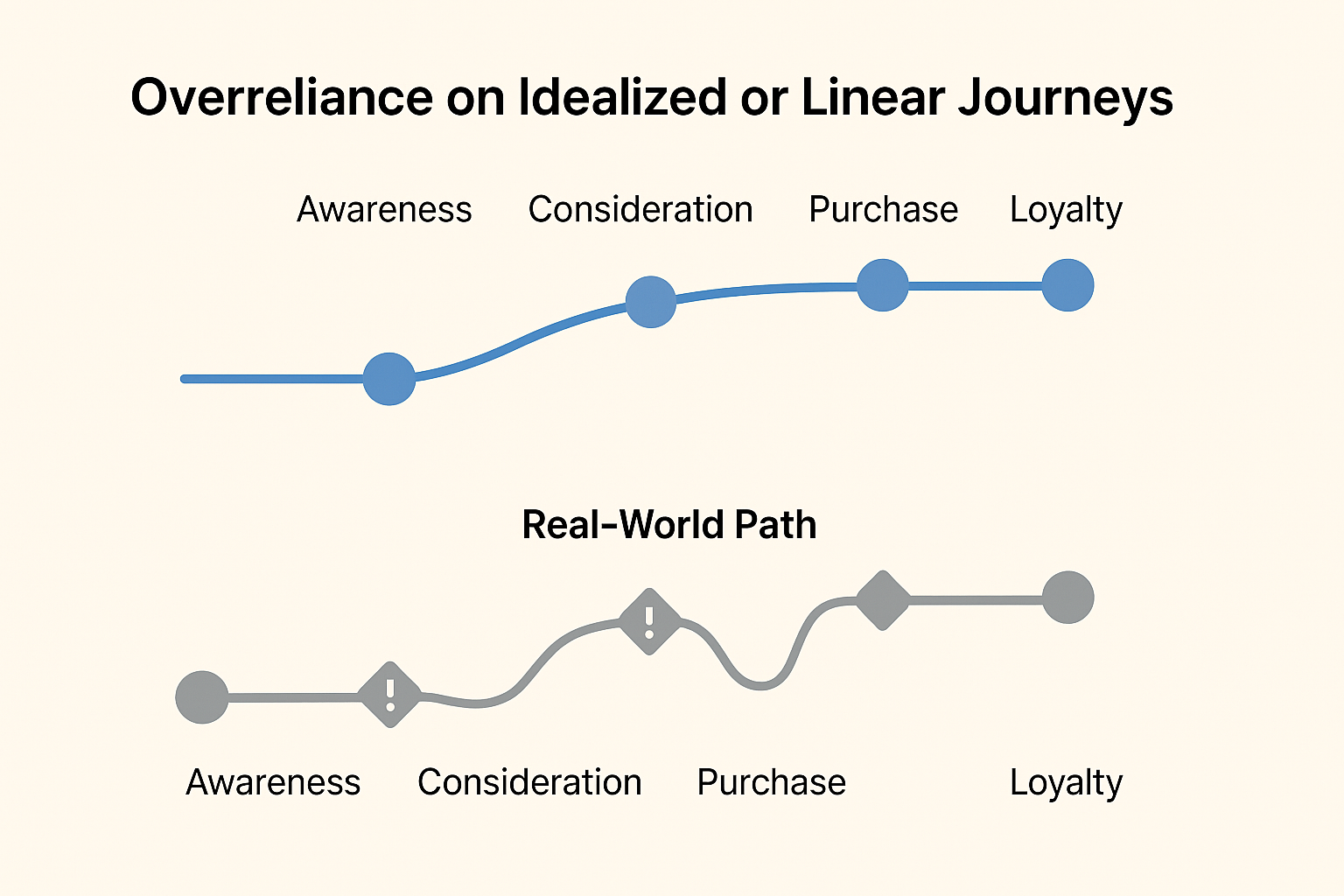Introduction
Customer Journey Mapping (CJM) has long been a cornerstone of Customer Experience (CX) strategy, offering organizations a structured approach to understanding how customers interact with their brand across various touchpoints. However, despite its widespread adoption across industries like banking, retail, finance, and SaaS, many organizations still face significant challenges in leveraging CJM effectively. In this article, we explore the common pitfalls of modern CJM practices, highlight the emerging opportunities for improvement, and provide actionable insights on how businesses can enhance their customer journey management processes.
As a professional with extensive experience in service design, user experience (UX), and customer experience (CX), I understand that creating truly impactful journey maps is not simply about gathering data—it’s about using that data to drive real change in service and product offerings. In my pursuit of a Customer Journey Management role, this article aims to showcase my deep understanding of CJM and how I would address the challenges and opportunities within this space.
1. Overreliance on Idealized or Linear Journeys

Modern customers do not follow a neat, linear path; they interact with brands in a messy, unpredictable manner. Yet many customer journey maps continue to depict an idealized, linear sequence where everything progresses smoothly. This “happy path” approach fails to capture the complexity of real-world customer behavior, which is non-linear, multifaceted, and full of detours.
Challenge: The “Happy Path” Trap
For instance, a typical banking app journey might show a straightforward path: the user sees an ad, downloads the app, fills out the necessary forms, and completes the account setup process. In reality, customers often face friction points like verification delays, multiple failed login attempts, or frustration with the app’s functionality. These real-world detours are often ignored in traditional mapping techniques, which leads to missed opportunities to address pain points.
Opportunity for Improvement
As organizations look to move towards more dynamic, adaptable CJM practices, I would focus on capturing the full range of customer journeys. By incorporating customer feedback, qualitative insights, and real-time data analytics, I can help create maps that reflect the varied paths customers take, rather than an oversimplified one-size-fits-all experience. This would enable the organization to not only identify friction points but also uncover new opportunities to streamline and personalize the journey for customers across multiple touchpoints.
2. Lack of Real-Time Data Integration and Dynamic Updates
Traditional CJM efforts rely heavily on static data, often collected through surveys or focus groups, which can become outdated quickly. A journey map created in the last quarter may no longer accurately reflect the evolving needs and behaviors of customers. This static approach hampers the organization’s ability to react to changing customer expectations, preferences, and behaviors.
Challenge: Outdated Insights
Consider a retail brand that maps out the customer journey for their in-store and online shopping experience. If the map is based on last year’s survey data, it may miss recent shifts in customer behavior, such as the growing demand for curbside pickup or changes in online product browsing due to a global pandemic. Failing to integrate real-time data means that organizations are making decisions based on outdated customer insights.
Opportunity for Improvement
In my role, I would implement continuous journey tracking, incorporating live customer data streams into the mapping process. Using modern tools that integrate real-time customer interactions, such as in-app behavior, website analytics, and customer service logs, would ensure that journey maps remain accurate and responsive to customer needs. Additionally, I would advocate for the use of journey management platforms that allow for continuous updates, ensuring the organization can make informed decisions quickly and drive customer-centric improvements.
3. Siloed Ownership vs. Cross-Functional Collaboration
Customer Journey Mapping is often seen as the responsibility of a single department—usually the CX or marketing team. This siloed approach can lead to incomplete or biased journey maps that fail to capture the full range of customer experiences, particularly when it comes to cross-channel interactions.
Challenge: Fragmented Perspectives
A banking institution, for example, might create a journey map that focuses solely on the digital banking experience, leaving out the in-branch or phone support interactions. This fragmented view doesn’t capture the true customer experience, especially when customers interact with multiple touchpoints during their journey. The lack of collaboration across departments leads to gaps in understanding, which ultimately impacts the customer’s experience.
Opportunity for Improvement
As a Customer Journey Manager, I would drive cross-functional collaboration, ensuring that teams from marketing, product, customer support, and IT work together to create a holistic map. I would facilitate workshops and working groups where all relevant departments can contribute insights, ensuring that the journey map reflects the full breadth of the customer experience. This collaborative approach helps break down silos, ensuring that every department has a shared understanding of customer needs and is aligned on how to address them.
4. Misalignment Between Map Insights and Actual Service/Product Design
Creating a beautiful, detailed customer journey map is one thing, but turning those insights into actionable improvements in product or service design is another. Many organizations struggle to translate the insights gathered from journey maps into tangible, customer-facing changes.
Challenge: Insights Not Translating to Action
Imagine a SaaS company that maps the onboarding journey and identifies friction points where users get stuck in the signup process. However, if the product team does not act on these insights by streamlining the process or providing more intuitive onboarding, the map’s insights will have little impact. This misalignment between mapping and execution often happens because the journey map is not directly tied to the product or service design process.
Opportunity for Improvement
To bridge this gap, I would ensure that journey mapping is closely tied to product development cycles. I would work alongside product teams to translate journey map insights into actionable design improvements. This might involve integrating customer pain points directly into the design backlog, ensuring that every customer frustration or opportunity identified in the journey map is addressed during the product iteration process. Additionally, I would facilitate regular feedback loops between CX teams and product designers to ensure that journey maps are continuously refined based on new insights.
5. Underrepresentation of Emotional and Behavioral Drivers
Customer behavior is not solely driven by functional needs; emotions, motivations, and psychological drivers play a significant role in how customers engage with a brand. However, many traditional journey maps fail to capture these emotional aspects, resulting in a one-dimensional view of the customer experience.
Challenge: Focusing Only on Functional Touchpoints
A retail brand might map the typical customer journey from awareness to purchase, highlighting touchpoints such as website visits, product discovery, and checkout. However, it may fail to capture the emotional journey—feelings of frustration when a customer cannot find a product in-store or the excitement of receiving a personalized offer. These emotional drivers are often the key to customer loyalty, yet they are frequently underrepresented.
Opportunity for Improvement
In my approach, I would integrate emotional mapping into the customer journey process. By leveraging qualitative research, such as customer interviews and surveys, I would capture customers’ emotional responses at each touchpoint. This could involve tracking emotional highs and lows throughout the journey and incorporating this data into the journey map to provide a richer, more nuanced understanding of the customer experience. Understanding the emotional drivers allows organizations to design experiences that build trust, reduce frustration, and ultimately increase customer loyalty.
6. Difficulty Integrating Omnichannel Experiences
Customers today interact with brands across multiple channels—online, mobile, in-store, via phone, and more. However, many journey maps still struggle to integrate these omnichannel experiences, leading to a disjointed view of the customer journey.
Challenge: Fragmented Channels
A telecom company might create separate journey maps for the in-store experience, the website, and the call center. However, the customer may switch between channels during their journey. For instance, a customer might research mobile plans on the website, visit a store for more information, and then call customer service for clarification before making a purchase. Treating each channel as separate without understanding how they work together results in a fragmented and incomplete view of the customer journey.
Opportunity for Improvement
I would focus on creating omnichannel journey maps that capture how customers transition between different touchpoints. This would involve mapping not only digital interactions but also physical touchpoints such as in-store visits or phone support. By leveraging data integration tools and journey management platforms, I would ensure that the organization captures a holistic view of the customer experience, regardless of the channels they use.
7. Challenges with Scalability and Ongoing Maintenance
As organizations grow and evolve, customer journeys become more complex, and maintaining accurate, up-to-date maps can become a challenge. Many organizations treat journey mapping as a one-time exercise, leaving maps to become outdated and irrelevant over time.
Challenge: Outdated Maps
A global financial institution might create an initial journey map that reflects customer behavior at a specific moment in time. However, as new services, products, or customer needs emerge, the map quickly becomes outdated, and the organization loses track of the evolving customer journey.
Opportunity for Improvement
To tackle this, I would establish a journey management program that ensures journey maps are regularly updated to reflect new data, insights, and market trends. By creating a continuous feedback loop and integrating real-time data streams, I would ensure that customer journey maps remain relevant, actionable, and scalable across the organization. This ongoing process would ensure that the organization is always aligned with the latest customer needs and expectations.
Conclusion
Customer Journey Mapping is an essential tool for improving CX, but it must evolve to meet the challenges of modern, dynamic customer behavior. By addressing the common pitfalls outlined in this article and implementing strategies for continuous improvement, I can help organizations create journey maps that are not only insightful but also actionable. As a Customer Journey Manager, my goal would be to bridge the gap between insight and action, ensuring that the customer journey is continuously optimized and aligned with business goals.
The evolving role of customer journey management requires a forward-thinking approach, one that embraces real-time data, emotional intelligence, and cross-functional collaboration. As I continue to develop my expertise in CJM, I look forward to contributing to a future where customer journeys are seamlessly integrated across channels, continuously updated with real-time insights, and ultimately drive business success.
Key Takeaways:
-
Customer journey mapping must move beyond linear journeys to reflect the complex, non-linear paths customers take.
-
Real-time data integration and dynamic updates are essential for keeping maps relevant and actionable.
-
Cross-functional collaboration is critical for creating holistic, comprehensive journey maps.
-
Emotional and behavioral drivers must be integrated into CJM to reflect true customer experiences.
-
Omnichannel integration is necessary to provide a seamless, continuous customer journey across touchpoints.
-
Ongoing maintenance and scalability are essential to keep journey maps aligned with evolving customer needs.

